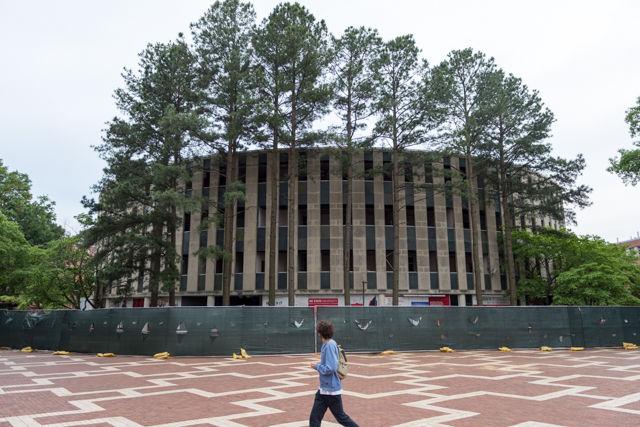
Bryan Murphy
A student walks through the brickyard and looks at the fenced off Harrelson Hall on May 18, 2016. Harrelson Hall is in the process of being cleaned out and its contents recycled so that the building can be demolished. The building is scheduled to be demolished in June and the area cleared out by August when classes begin again.
After many preparations, demolition on Harrelson Hall began this month. In its place will be a small park, adding some greenery to the Brickyard.
“We’re going to make a space, like a park,” said Steve Bostian, the project manager for the Harrelson demolition. “It’ll be landscaped nicely with some shrubs, trees, that sort of thing.”
The park will also include benches, lighting and pathways. It is only temporary, however, as the university plans to one day replace it with another building.
“Because we eventually plan to put a new science building there someday, we’re not planning on planting any trees that will become large trees,” Bostian said. “We’re looking to keep the vegetation and the shrubbery more of a moderate height so that it won’t get too big.”
A specific timeline for the new science building has not been put in place, but the building will likely be built five to 10 years from now, according to Josh Griffin of Kimley-Horn and Associates, Inc.
The university is taking measures to make sure students’ lives are as unaffected by the demolition as possible
“It shouldn’t affect [students] at all because the demolition will be inside of a construction fencing that will be closed off,” Bostian said. “And whenever we have trucks moving through campus, we’re going to have construction workers who will be monitoring traffic and helping trucks move in and out of that area so that there won’t be any safety issues with the students passing through that area.”
Some summer classes in Dabney and Cox Halls have been moved to either the side of the building opposite Harrelson or into another building in order to minimize the effects of the noise.
“There will be some noise, but we don’t think it’s going to be a disadvantage to students studying,” Bostian said. “That’s why we’re doing the demolition during the summer when the number of students on campus is less. If a person is inside D.H. Hill, I do not think it will impact their studying inside the building.”
On-campus research is also being taken into account.
“In the buildings surrounding Harrelson, there’s people doing experiments with some relatively sensitive equipment that is sensitive to unusual vibrations,” Bostian said. “Based on our calculations and analysis, we don’t think there’s going to be any issues because Cox and Dabney are both built on very deep piers, but we’re going to confirm that with the actual field measurements.”
Kimley-Horn and Associates, Inc., an international contracting company based in Greensboro, will be tearing down the building. Demolition is expected to end before classes begin in the fall.
“[Kimley-Horn] is an expert on demolition,” Bostian said. “They’ll do a very good job for us.”
Unlike other demolitions, Harrelson will not be imploded or struck with a wrecking ball. Rather, it will be sliced piece by piece with an excavator. Griffin said the method is similar to a game of Pac-Man.
With Harrelson gone the aesthetics of the Brickyard will greatly change, according to Bostian. Harrelson Hall was the first cylindrical building on a college campus, and included 103 staff offices and 58 classrooms, having a holding capacity of 4,500 students.
“You don’t realize how big of a building Harrelson is until you really think about it,” Bostian said. “We’re removing the building and the concrete slab, and it would look lik e a parking lot almost if we didn’t put some landscaping back. And we want to make our campus look nice.”
The demolition costs about $2 million, which is roughly $800,000 less than the budgeted amount.
“When the bid [price] came in, we were thrilled,” Bostian said.
Construction of the park will cost an additional $120,000.